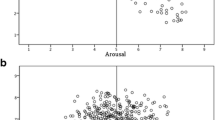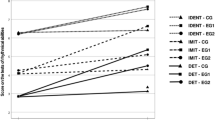Abstract
We present in this paper a media installation creating in real-time ambient electronic music from a multi-agent simulation by associating agents with sounds. More specifically, we associate various sound parameters with the internal state of an agent at a given time (position, orientation, internal variables, etc.), and therefore the evolution of an agent during the simulation will modify the corresponding soundscape. The sound sources are dynamically spatialized in the actual installation space through several loudspeakers (24 loudspeakers + 1 subwoofer) and modified in real-time, providing thus an ever-changing ambient soundscape. This generative music installation uses Nature-inspired simulations to drive the musical processes, and in particular the swarm intelligence metaphor.





Similar content being viewed by others
References
Ashmead DH, Leroy D, Odom RD (1990) Perception of the relative distances of nearby sound sources. Percept Psychophys 47(4):326–331
Beckers R, Deneubourg JL, Goss S (1992) Trail laying behaviour during food recruitment in the ant Lasius niger (L). Insect Soc 39:59–72
Blackwell T, Young M (2004) Self-organized music, Organised Sound, vol. 9, no. 2. Cambridge University Press, pp 123–136
Bonabeau E, Dorigo M, Theraulaz G (1999) Swarm intelligence: from natural to artificial systems. Oxford University Press
Braitenberg V (1984) Vehicles—experiments in synthetic psychology. MIT Press
Codognet P, Pasquet O (2009) Swarm intelligence for generative music, proceedings of ISM2009. IEEE International Symposium on Multimedia. IEEE Press, San Diego
Codognet P, Pasquet O (2010) Sound agents, proceedings of EvoApplications 2010, C Di Chio et al (eds) LNCS 6025, Springer Verlag
Couzin I, Krause J, James R, Ruxton GD, Franks NR (2002) Collective memory and spatial sorting in animal groups. J Theor Biol 218(1):1–11
Dahlstedt P, McBurney P (2006) Musical agents: towards computer-aided music composition using autonomous software agents. Leonardo 39(5):469–470
Davis T, Karamanlis O (2007) Gestural control of sonic swarms: composing with grouped sound objects. In: proc. SMC’07, 4 th Sound and Music Conference, Lefkada, Greece
Jin X, Wang CCL, Huang S, Xu J (2007) Interactive control of real-time crowd navigation in virtual environment, Proc. 2007 ACM symposium on Virtual Reality Software and Technology, pp 109–112, ACM Press
Lamarche F, Donikian S (2004) Crowd of virtual humans: a new approach for real time navigation in complex and structured environments. Comput Graphics Forum 23(3):509–518
Luke S, Cioffi-Revilla C, Panait L, Sullivan K (2004) MASON: a new multi-agent simulation toolkit, proceedings of SwarmFest04, 8 th Swarm Users/Researchers Conference, Ann Arbor, USA
Murray-Rust D, Smaill A, Contreras Maya M (2005) VirtuaLatin—towards a musical multi-agent system. In: Proceedings of ICCIMA’05, 6th International Conference on Computational Intelligence and Multimedia Applications, IEEE Press
Noma T, Zhao L, Badler NI (2000) Design of a virtual human presenter. IEEE Comput Graph Appl 20(4):79–85
Pachet F (2000) Rhythm as emerging structure. In: Proceedings of ICMC2000, International Conference on Computer Music, Berlin, Germany
Panait L, Luke S (2004) Ant foraging revisited. In: Proceedings of ALIFE9, 9th International Conference on the Simulation and Synthesis of Living Systems. USA, Boston
Pedica C, Vilhjalmsson H (2008) Social perception and steering for online avatars. In: Proc. IVA’08, 8th international conference on Intelligent Virtual Agents, Tokyo, Japan, LNAI 5208, Springer Verlag 2008, pp104–116
Reynolds CW (1987) Flocks, herds, and schools, a distributed behavioral model, Computer Graphics, vol. 21 no. 4 (SIGGRAPH '87 Conference Proceedings), pp. 25–34
Reynolds CW (1999) Steering behaviors for autonomous characters. In: Proc. of 1999 Game Developers Conference. Miller Freeman Group, San Francisco, pp 763–782
Robinson EJH, Jackson DE, Holcombe M, Ratnieks FLW (2005) Insect communication: ‘No entry’ signal in ant foraging. Nature 438:442
Shao W, Terzopoulos D (2005) Autonomous pedestrians. In: Proc. of the ACM SIGGRAPH’2005, Symposium on Computer Animation, ACM Publishing
Theile G (2004) Wave field synthesis—a promising spatial audio rendering concept. Proceedings of DAFX’04, 7th Int. Conference on Digital Audio Effects, Naples, Italy
Treuille A, Cooper S, Popovic Z (2006) Continuum crowds, ACM Transactions on Computer Graphics, vol. 25 no. 3 (SIGGRAPH 2006 conference proceedings), pp 1160–1168
Wulfhorst R, Nakayama L, Vicari R (2003) A multiagent approach for musical interactive systems. In: Proceedings of AAMAS'03, 2nd international joint conference on Autonomous agents and multiagent systems, Melbourne, Australia, ACM Press 2003, pp 584–591
Xenakis I (1963) Formalized music: thought and mathematics in composition. Indiana University Press 1971 (original edition in French, Musiques formelles)
Xiao H, He C (2009) Behavioral animation model for real-time crowd simulation. In: Proc. of 2009 International Conference on Advanced Computer Control, IEEE Press
Acknowledgement
We would like to thank the Japanese Ministry of Education, Culture, Sports, Science and Technology (MEXT) for partly supporting this research in 2008 at Keio University Research Institute for Digital Media and Content.
Author information
Authors and Affiliations
Corresponding author
Rights and permissions
About this article
Cite this article
Codognet, P., Pasquet, O. Ambient sound spaces. Multimed Tools Appl 58, 355–370 (2012). https://doi.org/10.1007/s11042-010-0666-0
Published:
Issue Date:
DOI: https://doi.org/10.1007/s11042-010-0666-0




